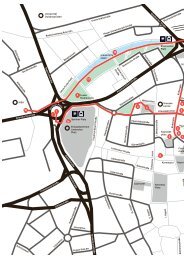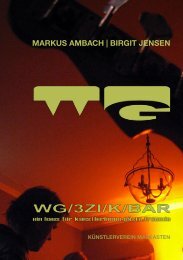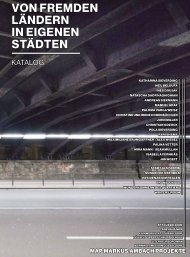B1|A40 THE BEAUTY OF THE GRAND ROAD
DIE SCHÖNHEIT DER GROSSEN STRASSE 2014 EINE AUSSTELLUNG IM STADTRAUM DER A40 VON DUISBURG BIS DORTMUND 14.06.2014 – 07.09.2014 MAP MARKUS AMBACH PROJEKTE URBANE KÜNSTE RUHR (HG.) WIENAND
DIE SCHÖNHEIT DER GROSSEN STRASSE 2014
EINE AUSSTELLUNG IM STADTRAUM DER A40 VON DUISBURG BIS DORTMUND
14.06.2014 – 07.09.2014
MAP MARKUS AMBACH PROJEKTE
URBANE KÜNSTE RUHR
(HG.)
WIENAND
You also want an ePaper? Increase the reach of your titles
YUMPU automatically turns print PDFs into web optimized ePapers that Google loves.
Polytopos Dortmund* ist Skulptur als Architektur,<br />
Display und funktionsloser Baukörper,<br />
Widmung und Umwidmung einer Situation,<br />
die Raum zu Diskurs und Betrachtung direkt<br />
am Schauplatz des Geschehens ermöglicht.<br />
Mit diesem temporären Ensemble verweist<br />
der Künstler auf all die Phänomene und Dinge,<br />
die man normalerweise nie sieht: die Verfasstheit<br />
einer über Jahre veränderten und<br />
entwickelten spezifisch gestalteten Landschaft,<br />
wie es sie nur im Ruhrgebiet zu geben<br />
scheint.<br />
SABINE MARIA SCHMIDT<br />
1| Eine Übersicht findet sich auf der Homepage<br />
des Künstlers [05.08.2015].<br />
2| „Das architektonische Zitat sagt mehr über den<br />
Zitierenden aus als über das Zitierte. Welche Referenzen<br />
werden zu Rate gezogen und welches Weltbild<br />
offenbart sich? Oft spielt Sehnsucht eine große<br />
Rolle; Zukunft als Wunschvergangenheit. Über das<br />
Kontextualisieren entstehen neue Verbindungen und<br />
Zusammenhänge, die in ihrer Bedeutung etwas Eigenes<br />
schaffen. Das Zitat kann sich aber auch auf einen<br />
archetypischen Kanon beziehen, so wie Aldo Rossi immer<br />
wieder Typologien bemühte. Jedoch ist die Grenze<br />
sehr schmal zwischen den Kategorien des Narrativen<br />
beziehungsweise Symbolischen zum Dekorativen einer<br />
kapitalistischen Konsumatmosphäre.“ Christian<br />
Odzuck, zit. aus: Ausst. Kat. Podróbka - Die Avantgarde<br />
gibt nicht auf, Städtische Galerie Danzig 2014, S. 84. Für<br />
die Gruppenausstellung konzipierte Odzuck die raumgreifende<br />
Skulptur Die indische Sonne, die zugleich als<br />
Möbel und Display diente und sich auf die Lichtdramaturgie<br />
der Fassade des High Court Buildings von Le<br />
Corbusier in Chandigarh bezog.<br />
3| Das Fassadenmodul wurde 1960 basierend auf<br />
einem Geschmacksmuster von Egon Eiermann für<br />
die Firma Horten weiterentwickelt und zu einer historischen<br />
Design-Ikone. Für die Düsseldorfer Fassade<br />
(Kaufhof, Berliner Allee) war allerdings Helmut<br />
Hentrich, Begründer von HPP Architekten, zuständig,<br />
der ebenfalls ein wabenähnliches Fassadenelement<br />
entwickelte. Im Gegensatz zu Egon Eiermann ließ<br />
sich HPP den Entwurf nicht patentieren, weshalb es<br />
oftmals zu Verwechslungen über die Urheberschaft<br />
kommt.<br />
4| <br />
[05.08.2015].<br />
5| Die „Schwimmbadplatte“ wurde aus neuem Material<br />
nachgebaut, da Originalmaterialien aus dem aus<br />
Kostengründen geschlossenen städtischen Berliner<br />
Bad in Mönchengladbach nicht verwendet werden<br />
konnten. Diese dienten aber als Vorlage für die Form.<br />
POLYTOPOS DORTMUND* Christian Odzuck<br />
loves books. Not so much as a medium for text<br />
and literature as for an archival compendium,<br />
a sketchbook that documents the beginning of<br />
a work in all of its facets, from his analyses,<br />
sketches, and ideas, to research and completion.<br />
Frequently, these become artist’s books,<br />
whose minimal design speaks for themselves,<br />
without further commentary. Their often-expansive<br />
physical and material qualities allow<br />
them to be read as sculptural objects or conceptual,<br />
architectural projects. 1 For Odzuck,<br />
the book is, above all, a utopian place that<br />
helps one to visualize free ideas, regardless of<br />
whether they can be realized or not. Do sculptures<br />
or crazy architectural designs have to be<br />
realized, or is it enough to manifest them in images?<br />
From what point on are models necessary?<br />
And isn’t sculpture itself a model that is<br />
primarily intended to serve as an instrument<br />
for the continual perception of our urban and<br />
architectural environment?<br />
In recent years Christian Odzuck has realized<br />
many projects and concepts devoted to architectonic<br />
space and its object-like qualities.<br />
Here, as he often says, his interest is focused<br />
on architecture as a system of order that always<br />
boasts a historical, political, and ideological<br />
subtext. He prefers the geometrical,<br />
graphic, mathematical, and abstract formal<br />
and linguistic vocabulary used by architecture<br />
in the 1950s and 1960s, along with its multilayered<br />
network of social and political references.<br />
Odzuck doesn’t superficially reckon with<br />
architectural and tourism highlights. Rather,<br />
he approaches his work via detours and chains<br />
of reception, in a confrontation with the sacred<br />
pillars of Modernism. 2 Many interventions<br />
begin when neglect of this period’s architectural<br />
legacy sets in, or when a great deal of<br />
renovation is necessary. Others start when it<br />
is already too late, or when people realize that<br />
once carefully designed elements of functional<br />
architecture need to be rescued – such as the<br />
recent, time-consuming salvage of so-called<br />
Horten tiles from a department store’s façade<br />
in Düsseldorf. 3<br />
Two of Odzuck’s most frequently cited projects<br />
are the sculptures Temporäre Abkühlung (Temporary<br />
chilling, 2013) and Geozentrik (Geocentric,<br />
2014) in Mönchengladbach, 4 which were<br />
made for the three-year project, Ein ahnungsloser<br />
Traum vom Park (An Innocent Dream of a<br />
Park). The first consisted of a plateau of swimming<br />
pool fragments shaped into a lounger 5<br />
with an operational water hydrant; as a temporary<br />
sculpture, it actually offered water so that<br />
people could temporary cool off. Geozentrik is,<br />
formally speaking, a highly complex synthesis<br />
of recycled materials and shapes that cite<br />
the immediate surroundings. An island zone<br />
in the park, set up like a metaphorical pergola,<br />
is made of drainpipes and scrapped air<br />
ducts from a defunct swimming pool. Three<br />
accompanying concrete benches are faithfully<br />
detailed casts of discarded Burger King furniture<br />
from the 1980s. Everything is composed<br />
of pieces found in and around Mönchengladbach.<br />
In turn, the ensemble’s design goes back<br />
to the diagonal, geometric pattern of the neon<br />
ceilings in the neighboring Museum Abteiberg,<br />
designed by the architect Hans Hollein. In a<br />
nutshell: it was a strange place that immediately<br />
became a spontaneous meeting spot, especially<br />
for young people.<br />
Odzuck’s present-day archeology is always<br />
related to a situation or a site; it’s precisely<br />
formulated, aesthetically balanced, and never<br />
favors sides or ideologies. It is marked by ambivalent<br />
knowledge about the threatened decay<br />
of modern architecture, about the ruined and<br />
the rusty, the depletion of resources, as artists<br />
from the 1970s (Robert Smithson, Sol LeWitt,<br />
Gordon Matta-Clark) taught. It feeds on the notion<br />
that even in a new building you can see its<br />
decaying ruin; at the same time it reminds you<br />
of what once stood in the same place or of what<br />
might stand there at some point in the future.<br />
His works, which also always retain aspects<br />
of a kind of crystalline utopia, at first seem to<br />
subsist on what is there, on bricolage and the<br />
concept of recycling, and then they reactivate<br />
the former “utopian potential” of architecture<br />
and spaces by re-fictionalizing spaces that<br />
could be used for creativity and action.<br />
Odzuck does not shy away from architectural<br />
size – even monumental setups in public spaces<br />
– which he undermines with the concept of<br />
“ephemeral monumentalism.” When he decides<br />
to realize them, the artist understands<br />
POLYTOPOS DORTMUND* CHRISTIAN ODZUCK<br />
261












